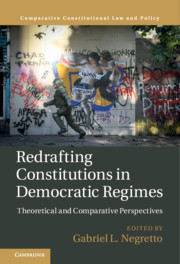Book contents
- Redrafting Constitutions in Democratic Regimes
- Comparative Constitutional Law and Policy
- Redrafting Constitutions in Democratic Regimes
- Copyright page
- Dedication
- Contents
- Tables
- Contributors
- Acknowledgments
- 1 New Constitutions in Democratic Regimes
- Part I Conceptual, Normative, and Empirical Issues
- Part II Case Studies
- 6 The Difference Power Diffusion Makes
- 7 Democratic Constitutional Replacements and Majoritarian Politics
- 8 Thailand’s Democratic Moment
- 9 Political Elites and the People
- 10 The Anatomy of Constitution Making
- Index
- References
10 - The Anatomy of Constitution Making
From Denmark in 1849 to Iceland in 2017
from Part II - Case Studies
Published online by Cambridge University Press: 29 August 2020
- Redrafting Constitutions in Democratic Regimes
- Comparative Constitutional Law and Policy
- Redrafting Constitutions in Democratic Regimes
- Copyright page
- Dedication
- Contents
- Tables
- Contributors
- Acknowledgments
- 1 New Constitutions in Democratic Regimes
- Part I Conceptual, Normative, and Empirical Issues
- Part II Case Studies
- 6 The Difference Power Diffusion Makes
- 7 Democratic Constitutional Replacements and Majoritarian Politics
- 8 Thailand’s Democratic Moment
- 9 Political Elites and the People
- 10 The Anatomy of Constitution Making
- Index
- References
Summary
This chapter reviews aspects of the constitution-making process in Iceland after the financial collapse of 2008, emphasizing the differences between the provisional constitution of 1944 when Iceland separated unilaterally from Nazi-occupied Denmark and Denmark’s 1849 constitution which served, with notable exceptions, as the prototype for Iceland’s 1944 constitution. The comparison and contrast between the Icelandic and Danish constitutions invites a comparison also between Iceland’s 1944 constitution with the new post-crash constitution from 2011 accepted by two-thirds of the voters in a national referendum in 2012 and waiting to be ratified twice by a reluctant Parliament. Against this comparative background, the chapter proceeds to discuss political and procedural aspects of Iceland´s constitutional reform project, and concludes by proposing lessons to be learned from Iceland´s experience thus far.
- Type
- Chapter
- Information
- Redrafting Constitutions in Democratic RegimesTheoretical and Comparative Perspectives, pp. 217 - 240Publisher: Cambridge University PressPrint publication year: 2020
References
- 1
- Cited by

